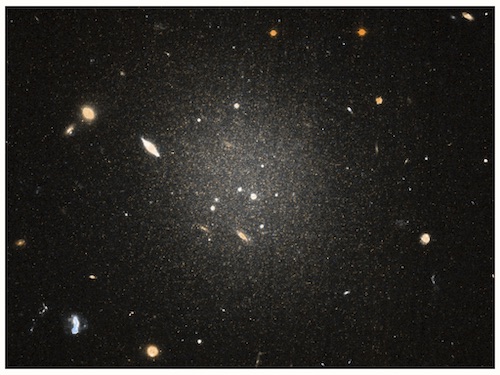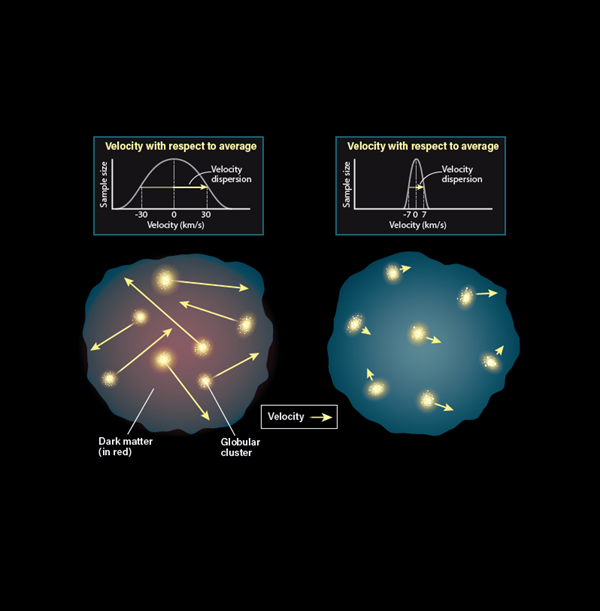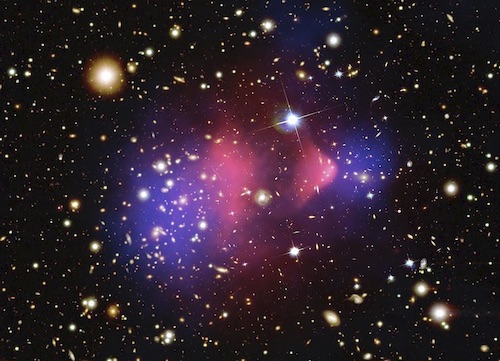Key Takeaways:
Some 60 million light-years from Earth — by some researchers’ estimate, anyway — a pair of strange galaxies is causing a cosmic stir. These island universes hold far fewer stars than your average galaxy. But it’s not the lack of stars that surprises astronomers. The bizarre galaxies, named NGC 1052-DF2 and NGC 1052-DF4 (or DF2 and DF4, for short), also seem to lack any significant amount of dark matter.
Because the duo could be the first known galaxies without the substance, which accounts for 85 percent of the universe’s matter, news of DF2’s discovery in 2018 quickly spread throughout the astronomical community. If confirmed, such galaxies without dark matter would throw a wrench into our understanding of how galaxies form and evolve.
“We thought that every galaxy had dark matter and that dark matter is how a galaxy begins,” astrophysicist Pieter van Dokkum of Yale University, lead author of the initial paper on DF2, said in a press release. “This invisible, mysterious substance is the most dominant aspect of any galaxy. So finding a galaxy without it is unexpected. It challenges the standard ideas of how we think galaxies work, and it shows that dark matter is real: It has its own separate existence apart from other components of galaxies.”
What is DF2?
DF2, the first known galaxy supposedly devoid of dark matter, is a member of a unique class of galaxies called ultra-diffuse galaxies (UDGs). Although UDGs can grow as large as the Milky Way, these hazy specters contain hundreds to thousands of times fewer stars. And because they’re essentially transparent, they’re extremely difficult for astronomers to observe in detail.

How did we discover dark matter? What is dark matter made of? How is dark matter different than dark energy? Astronomy’s free downloadable eBook, The Science Behind Dark Matter, contains everything you need to know about the elusive and invisible substance.
“I spent an hour just staring at the Hubble image,” said van Dokkum. “It’s so rare, particularly these days after so many years of Hubble, that you get an image of something and you say, ‘I’ve never seen that before.’ This thing is astonishing — a gigantic blob that you can look through. It’s so sparse that you see all of the galaxies behind it. It is literally a see-through galaxy.”
Using the Hubble data, van Dokkum and his team measured the galaxy’s surface brightness fluctuations, which is a rudimentary distance indicator based on the fact that more distant galaxies appear more uniform in brightness. From this, the researchers calculated DF2 is located about 65 million light-years away.
Then, based on the Keck data, van Dokkum’s team identified globular clusters (large, spherical groups of old stars) within DF2. Surprisingly, they found the globular clusters were moving at a snail’s pace compared to what we would see if the galaxy were chock-full of dark matter. If DF2 had more dark matter, van Dokkum says, the increased gravitational pull would cause these clusters to move about three times faster than they do.
The realization that DF2 seems to have very little, if any, dark matter caught the researchers off guard because it’s the first galaxy found lacking the pervasive material. “There is no theory that predicted these types of galaxies. The galaxy is a complete mystery, as everything about it is strange,” said van Dokkum. “How you actually go about forming one of these things is completely unknown.”
However, not everyone agrees that DF2 is missing its dark matter.
Debating DF2’s distance
“Something that caught my attention very early on was the fact that the galaxy was not only anomalous for not having dark matter, but also for having an extraordinarily bright population of globular clusters,” says Ignacio Trujillo of the Instituto de Astrofísica de Canarias, who led the main study challenging the bizarre nature of DF2. “I remember thinking: ‘Two anomalies at the same time really looks odd.’ ” This led Trujillo to consider whether DF2 is really as distant as van Dokkum’s team thinks.
To test their theory, Trujillo and his team set off to independently determine the distance to DF2 using five different methods — all with varying degrees of trustworthiness.
Two of the methods relied on analyzing the brightnesses and sizes of DF2’s globular clusters. According to the short-distance camp, if DF2 is closer than initially thought, then the galaxy’s globular clusters no longer would be weirdly big and bright. Trujillo’s team also compared DF2’s properties to a similar galaxy, called DD044, which has a more reliable distance estimate, as well as recalculated DF2’s distance using the same surface brightness fluctuation method (with different calibrations) as van Dokkum’s team.
Finally, Trujillo’s team analyzed the tip of the red giant branch (TRGB) in DF2’s color-magnitude diagram, which plots the surface temperatures and luminosities of stars within a galaxy. Because the brightest red giant stars all shine with same true brightness in infrared light, the only thing that should dramatically impact how bright they appear to us is their distance. So, by identifying how bright the stars on the TRGB look for a given galaxy, researchers can get a good grasp on how far away the galaxy really is.
“This is, by far, the most accurate way of measuring the distance to the galaxy if the data have good quality,” Trujillo says. Based on all five methods, Trujillo and his team determined DF2 is likely only about 42 million light-years away, rather than some 65 million light-years away. This, Trujillo argues, would mean that DF2 isn’t as strange as initially thought, and instead harbors about as much dark matter as you would expect from an average, run-of-the-mill galaxy.
In August 2018, his team published yet another paper in response. In it, they argue Trujillo’s “five ‘independent measurements’ are a bit misleading.” For instance, van Dokkum says, “three of them are circular, in the sense that the authors argue that the properties of the galaxy would be less strange if it were at a closer distance.” Plus, van Dokkum argues, the short-distance camp based their most convincing distance estimate on a “phantom” TRGB that’s nearly twice as bright as the galaxy’s true TRGB. This, van Dokkum says, led Trujillo’s team to calculate a distance to DF2 that’s only about 70 percent the actual value.
After showing why they think Trujillo’s shorter distance to DF2 was due to blends in the TRGB data — where multiple stars were counted together as a single, bright red giant — van Dokkum’s team went on to provide a new distance measurement to DF2 they claim is independent of calibration uncertainties. Their result: DF2 is about 61 million light-years away, which would mean DF2 still has a negligible amount of dark matter.
What about DF4?
But the debate didn’t stop there.
After this academic back-and-forth, van Dokkum and his team found a second galaxy, DF4, which is nearly a clone of DF2 in terms of its size, surface brightness, morphology, location, and distance. But, most importantly, DF4 likewise has an apparent dearth of dark matter.
Using the Keck Telescope to measure the motion and speed of DF4’s diffuse gas, as well as seven of its globular clusters, van Dokkum’s team calculated that DF4’s distance is similar to DF2’s — hovering around 65 million light-years away, give or take about 9 million light-years.
“We conclude that NGC 1052-DF2 is not an isolated case, but that a class of such objects exists,” van Dokkum’s team wrote in their DF4 discovery paper. “The origin of these large, faint galaxies with an excess of luminous globular clusters and an apparent lack of dark matter is, at present, not understood.”
But, yet again, Trujillo and his team calculated their own distance to DF4. Based on Hubble data available at the time, they identified what they think is DF4’s TRGB. This led them to conclude that DF4 is about 46 million light-years away, which would mean its globular clusters aren’t actually that strange, and instead are pretty similar to those found in the Milky Way and elsewhere.
“All in all,” Trujillo’s team concluded in their response paper, “the proposition that both NGC 1052-DF2 and NGC 1052-DF4 are ‘missing dark matter’ is still far from being placed on sure footing.”
Hubble takes another look
In the summer of 2019, in order to determine whether Trujillo’s team had identified DF4’s true TRGB, van Dokkum’s group used Hubble’s keen eye to collect new, deep images of DF4. On October 16, they posted another paper, which has been submitted to The Astrophysical Journal Letters, on the preprint site arXiv. Based on the fresh Hubble data, which picked up many more, much fainter stars, the paper claims the short-distance camp again misidentified DF4’s brightest red giant stars, leading to a closer derived distance.
“In the new data, there really is no ambiguity,” says study author Shany Danieli of Yale, who is van Dokkum’s colleague. “We think the new data really rule out the [shorter-distance] option.”
But after reviewing the new research, Trujillo is still dubious of the study’s conclusion. “At the moment, I remain enormously skeptical about their outcome of a long distance for DF4,” Trujillo says. “The first thing you should note is that this paper has still not [been] accepted by the referee and/or the journal,” he explains. “It has been only submitted; therefore, further changes of its content can be expected after a careful reading by the referee.”
Then there’s also the matter of how van Dokkum’s long-distance camp selected which of DF4’s stars they would include in their TRGB analysis, which is yet another point of contention. “I think there are a number of choices [van Dokkum’s group] have used that have not been justified,” Trujillo says. “All of these choices seem to be selected to favor a larger distance than what the data suggests.”
One such choice, Trujillo explains, is that the quality cuts van Dokkum’s team used to pick which stars were included in their analysis seem to ignore many stars. Another, he adds, is that van Dokkum’s team made “a preselection of their stars based on the colors” and they do not explain why or how that impacts their outcome. Both of these choices, Trujillo says, could greatly impact the derived distance to DF4.
What’s next?
So, at this stage, the answer to whether DF2 and DF4 have dark matter or not is still largely up in the air. But just before this issue went to press, new research published November 25 in Nature Astronomy reported the discovery of 19 dwarf galaxies that likewise seem to be severely lacking in dark matter. So stay tuned for more on that in a later issue.
However, no matter what’s really going with these galaxies without dark matter, van Dokkum says, “The broader point is that these are fascinating galaxies, and all aspects of our findings should certainly be questioned and scrutinized.”
So if these latest results hold up to the scrutiny that’s likely to come, then finding galaxies missing dark matter would completely change our understanding of how we think galaxies form and evolve.
“The galaxies point to an alternative channel for building galaxies — and they even raise the question whether we understand what a galaxy is,” says van Dokkum. Right now, we think that galaxies begin with dark matter, which is how they’re able to gravitationally attract the massive amounts of gas and dust needed to kick-start star formation.
“The thing is, we have no idea how star formation would proceed in the absence of dark matter,” van Dokkum says. “All we can say is that there must have been very dense gas early on in their history,” otherwise, galaxies without dark matter couldn’t create new stars.
But is this latest distance determination to DF4 really robust enough to start exploring the implications of finding a galaxy without dark matter?
“Yes, that’s our hope. We’d love to move to discuss what these galaxies mean, rather than whether our measurements were correct,” Danieli says.
“That said,” she adds, “we fully agree with everyone that ‘extraordinary claims require extraordinary evidence.’ ”

















